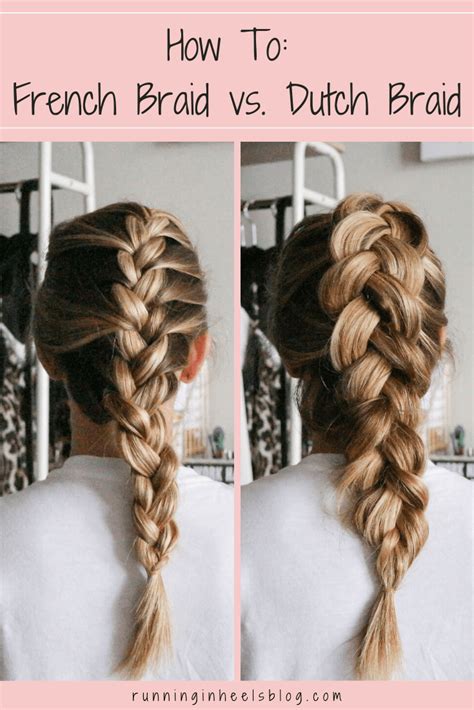Introduction
Embark on a journey into the realm of hairstyling artistry, where the intricate dance of braids takes center stage. Unravel the secrets of two renowned techniques: the French braid and the Dutch braid. Master the nuances that set them apart, unlocking endless possibilities for captivating hairstyles that empower self-expression.

Embracing the French Braid
The French braid, also fondly known as the “French plait,” has captivated the hearts of fashionistas worldwide with its timeless elegance. This intricate technique involves meticulously weaving three strands of hair together, intertwining them in a downward direction.
- Step-by-Step Guide:
- Gather a section of hair from the top of your head.
- Divide the section into three equal strands.
- Cross the right strand over the middle strand.
- Cross the left strand over the new middle strand (previously the right strand).
- Repeat steps 3 and 4, gradually incorporating more hair from the sides as you braid downwards.
- Secure the braid with an elastic band or ribbon.
The Allure of the Dutch Braid
Step into the realm of boldness with the Dutch braid, an inverted counterpart to the French braid. Its captivating allure lies in the upward intertwining of strands, creating a raised and voluminous effect.
- Step-by-Step Guide:
- Gather a section of hair from the top of your head.
- Divide the section into three equal strands.
- Cross the right strand under the middle strand.
- Cross the left strand under the new middle strand (previously the right strand).
- Repeat steps 3 and 4, gradually incorporating more hair from the sides as you braid upwards.
- Secure the braid with an elastic band or ribbon.
Unlocking the Distinctions
While both French and Dutch braids share the essential structure of three interwoven strands, their direction of intertwining creates distinct characteristics:
| Feature | French Braid | Dutch Braid |
|---|---|---|
| Direction of intertwining | Downward | Upward |
| Volume | Flatter | Raised and voluminous |
| Appearance | More subtle | More prominent |
| Difficulty | Easier to master | Requires more practice |
Which Braid Reigns Supreme?
The choice between a French braid and a Dutch braid depends on your hairstyle preferences and personal style. Here’s a handy guide to help you make an informed decision:
- French Braid: Opt for this timeless classic if you prefer a refined and elegant look. Its flatter appearance complements formal occasions and everyday wear.
- Dutch Braid: Embrace the Dutch braid’s bold and eye-catching volume for a statement look. It adds a touch of drama to casual outfits and elevates special events.
Braididolizing: The Art of Creative Applications
Beyond traditional hairstyles, these versatile braids lend themselves to countless creative applications. Unleash your imagination and explore the following possibilities:
- Bridal Beauty: Adorn your tresses with intricate French braids for a timeless and sophisticated bridal look.
- Everyday Glamour: Elevate your everyday style by effortlessly incorporating Dutch braids into half-updos, ponytails, or even buns.
- Intricate Cornrows: Experiment with cornrows, a variation of Dutch braids, to create geometric patterns and add texture to natural hair.
- Halo Braids: Combine French and Dutch braids to form a halo around your head for an ethereal and eye-catching effect.
Tables for Enhanced Understanding
- Table 1: Advantages and Disadvantages of French Braids
| Advantages | Disadvantages |
|---|---|
| Timeless elegance | Flatter appearance |
| Easy to master | May not be suitable for all hair types |
| Versatile for various hairstyles | Can be time-consuming to create |
- Table 2: Advantages and Disadvantages of Dutch Braids
| Advantages | Disadvantages |
|---|---|
| Bold and voluminous | Requires more practice to master |
| Statement look | May not be suitable for formal occasions |
| Adds drama to hairstyles | Can be more difficult to incorporate into complex buns |
- Table 3: Hairstyle Ideas Incorporating French and Dutch Braids
| Style | Description |
|---|---|
| French Braid Ponytail | Classic ponytail adorned with a French braid |
| Dutch Braid Crown | Intricate Dutch braid wrapped around the head |
| Half-Up, Half-Down with French Braids | Half-up hairstyle with French braids accentuating the sides |
| Cornrow Halo | Halo of cornrows (Dutch braid variation) surrounding the head |
- Table 4: Expert Tips for Perfect Braiding
| Tip | Description |
|---|---|
| Use a detangling brush to remove knots before braiding | |
| Slightly dampen hair to make it easier to work with | |
| Divide hair into thin, even strands for a neat braid | |
| Keep tension consistent to avoid loose or tight braids | |
| Practice regularly to enhance your braiding skills |
Engage in Customer-Centric Dialogue
To truly understand the power of French and Dutch braids, engage in customer-centric dialogue. Ask intriguing questions to validate customers’ perspectives and delve into their wants and needs. Explore their reasons for choosing one braid over the other and identify the benefits that matter most. By actively listening and empathizing, you’ll gain invaluable insights to tailor your recommendations and create hairstyles that resonate with customers’ aspirations.
Conclusion
Embrace the artistry of French and Dutch braids, unlocking endless possibilities to elevate your hairstyles. Whether you seek timeless elegance or bold drama, these intricate techniques empower self-expression and unleash your creativity. Experiment with various applications and engage in customer-centric dialogue to ensure that your braiding skills leave a lasting impression. Remember, the true beauty of braids lies in their ability to transform and inspire, empowering you to embrace your unique style with confidence.
